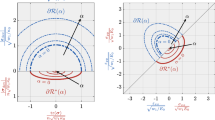Abstract
A detailed discrete dislocation analysis has been carried out in order to understand the behavior of a shear crack. It is found that a shear crack can be classified broadly into four categories based on its elastic and plastic behavior. The realistic growth of a plastic crack is found to take place by emission of lattice dislocations whenever the crack can reduce its energy, otherwise it expands elastically. The elastic energy released when the plastic crack forms is related to the self energy and interaction energy of the dislocations along with the frictional energy expended in creating the plastic zone. The plastic work for a plastic crack defined earlier by Orowan is obtained as a function of the energy terms contributing to the total energy of the plastic crack, namely the frictional work and the work done by the applied stress in creating the plastic zone.
Résumé
Une analyse discrète détaillée des dislocations a été effectuée en vue de comprendre le comportement d'une fissure de cisaillement. On a trouvé qu'une fissure de cisaillement peut être généralement classée en quatre catégories, selon son comportement élastique ou plastique. On trouve que la croissance réaliste d'une fissure dans des conditions plastiques peut se produire par l'émission de dislocations dans le réseau, lesquelles produisent une réduction de l'énergie de la fissure, qui se propageait précédemment de manière élastique. L'énergie élastique libérée lorsque se forme la fissure plastique est mise en relation avec l'énergie propre et l'énergie d'interaction des dislocations ainsi qu'avec l'énergie de friction dépensée pour créer la zône plastique. Le travail plastique associé à une fissure plastique et défini précédemment par Orowan est obtenu en fonction des termes d'énergie contribuant à l'énergie totale de la fissure plastique, notamment le travail de friction et le travail effectué par la contrainte appliquée pour créer la zône plastique.
Similar content being viewed by others
References
[K.] Jagannadham and M.J. Marcinkowski, Physica Stat. Solidi. In press.
M.J. Marcinkowski and R.W.: Armstrong, Journal of Applied Physics, 1972 (43) 2548.
M.J. Marcinkowski, Journal of Applied Physics, 1975 (46) 496.
M.J. Marcinkowski and E.S.P. Das, Physica Stat. Solidi, 1971 (A8) 249.
K. Sadananda, K. Jagannadham and M.J. Marcinkowski, Physica Stat. Solidi, 1977 (A44) 633.
J.R. Rice, in Fracture, An advanced treatise, Chapter 3, Vol. II, edited by H. Liebowitz, Academic Press, New York, (1968).
E. Orowan, in Fatigue and Fracture of Metals, Symposium at M.I.T., John Wiley & Sons, Inc., New York.
B.A. Bilby, A.H. Cottrell and K.H. Swinden, Proceedings of the Royal Society (London), 1963 (272A) 304.
Author information
Authors and Affiliations
Rights and permissions
About this article
Cite this article
Jagannadham, K., Marcinkowski, M.J. Discrete dislocation analysis of a plastic shear crack. Int J Fract 15, 119–133 (1979). https://doi.org/10.1007/BF00037828
Received:
Revised:
Issue Date:
DOI: https://doi.org/10.1007/BF00037828




